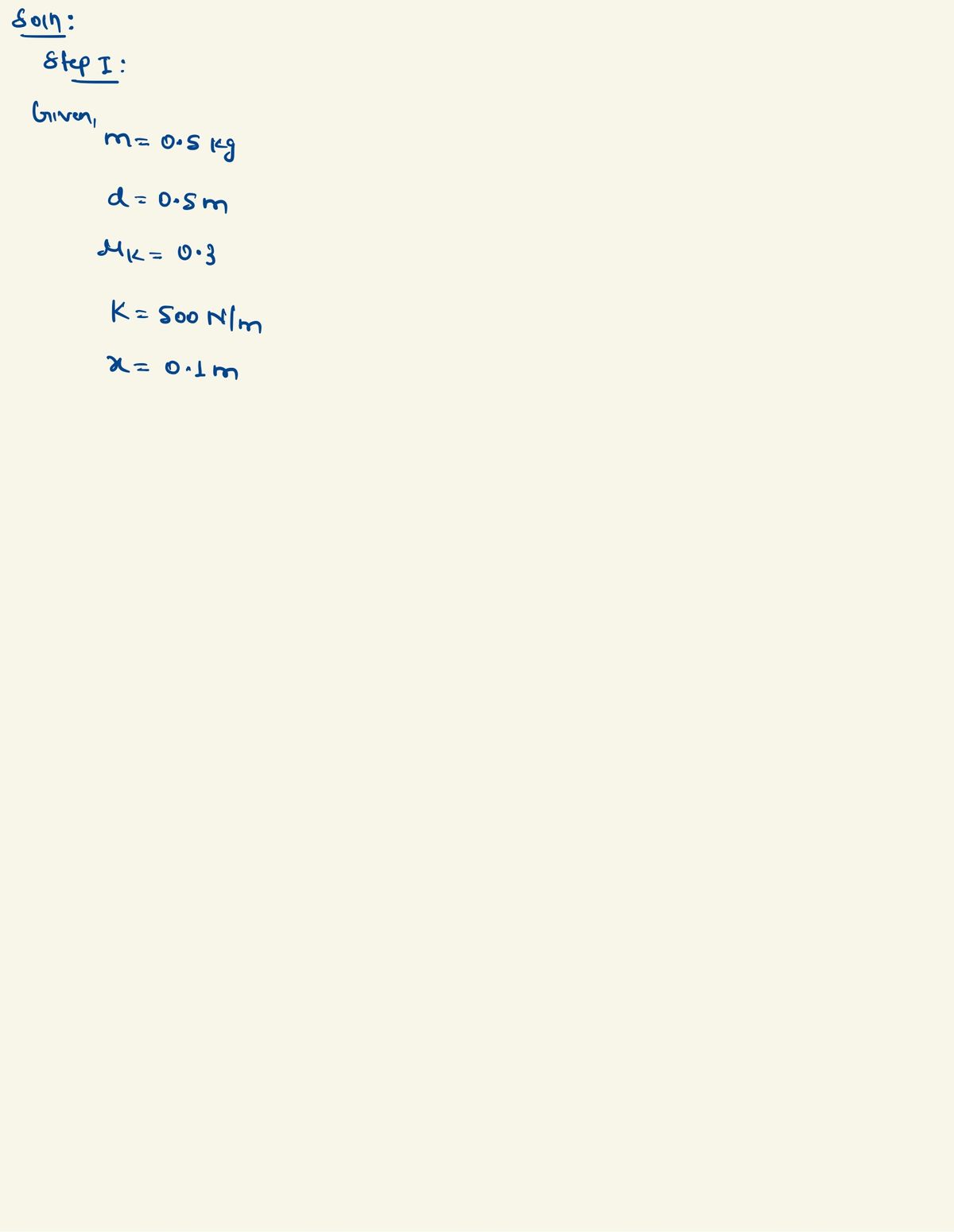In the Figure below, we see a 500 gram block resting on the horizontal portion of a "track", whose left end is curved upwards. The horizontal portion of the track is frictionless, except for a 50.0 cm long "rough" portion, shown in the Figure, where the coefficient of kinetic friction is 0.300. The curved portion of the track is frictionless. The block is held against a spring (which has a stiffness constant of 500 N/m), compressing the spring by 10.0 cm. Then the block is released from rest. (NOTE: The block is not attached to the spring; it is just held against the end of the spring.) For simplicity, assume that g = 9.80 m/2. 50.0 cm
In the Figure below, we see a 500 gram block resting on the horizontal portion of a "track", whose left end is curved upwards. The horizontal portion of the track is frictionless, except for a 50.0 cm long "rough" portion, shown in the Figure, where the coefficient of kinetic friction is 0.300. The curved portion of the track is frictionless. The block is held against a spring (which has a stiffness constant of 500 N/m), compressing the spring by 10.0 cm. Then the block is released from rest. (NOTE: The block is not attached to the spring; it is just held against the end of the spring.) For simplicity, assume that g = 9.80 m/2. 50.0 cm
College Physics
11th Edition
ISBN:9781305952300
Author:Raymond A. Serway, Chris Vuille
Publisher:Raymond A. Serway, Chris Vuille
Chapter1: Units, Trigonometry. And Vectors
Section: Chapter Questions
Problem 1CQ: Estimate the order of magnitude of the length, in meters, of each of the following; (a) a mouse, (b)...
Related questions
Question
#15

Transcribed Image Text:In the Figure below, we see a 500 gram block resting on the horizontal portion of a "track", whose left end is curved upwards.
The horizontal portion of the track is frictionless, except for a 50.0 cm long “rough" portion, shown in the Figure, where the
coefficient of kinetic friction is 0.300. The curved portion of the track is frictionless. The block is held against a spring (which
has a stiffness constant of 500 N/m), compressing the spring by 10.0 cm. Then the block is released from rest. (NOTE: The block
is not attached to the spring; it is just held against the end of the spring.) For simplicity, assume that g = 9.80 m/2.
50.0 cm

Transcribed Image Text:12. How much work is done on the block by gravity as the block slides up to its highest point on the curved portion of the track?
A. 1.77 J.
B. - 2.50 J.
C. zero.
D. - 0.735 J.
E. - 1.77 J.
13. Through what vertical distance does the block rise as it slides up to its highest point on the curved portion of the track?
A. 51.0 cm.
B. 36.0 cm.
C. 15.0 cm.
D. 3.53 cm.
E. 13.6 cm.
14. Find the change in the gravitational potential energy of the system as the block slides up to its highest point on the curved
portion of the track.
A. 0.735 J.
B. - 1.77J.
C. 1.77 J.
D. 2.50 J.
E. - 2.50 J.
15. Consider the period of time which starts at the instant when the block is released from rest and which extends to the instant
when the block comes to rest at its highest point on the curved portions of the track. The change in the elastic spring potential
energy of the system is
A. 2.50 J.
B. 1.77 J.
C. - 2.50 kJ.
D. - 2.50 J.
E. -1.77 J.
Expert Solution
Step 1

Trending now
This is a popular solution!
Step by step
Solved in 2 steps with 2 images

Knowledge Booster
Learn more about
Need a deep-dive on the concept behind this application? Look no further. Learn more about this topic, physics and related others by exploring similar questions and additional content below.Recommended textbooks for you

College Physics
Physics
ISBN:
9781305952300
Author:
Raymond A. Serway, Chris Vuille
Publisher:
Cengage Learning

University Physics (14th Edition)
Physics
ISBN:
9780133969290
Author:
Hugh D. Young, Roger A. Freedman
Publisher:
PEARSON

Introduction To Quantum Mechanics
Physics
ISBN:
9781107189638
Author:
Griffiths, David J., Schroeter, Darrell F.
Publisher:
Cambridge University Press

College Physics
Physics
ISBN:
9781305952300
Author:
Raymond A. Serway, Chris Vuille
Publisher:
Cengage Learning

University Physics (14th Edition)
Physics
ISBN:
9780133969290
Author:
Hugh D. Young, Roger A. Freedman
Publisher:
PEARSON

Introduction To Quantum Mechanics
Physics
ISBN:
9781107189638
Author:
Griffiths, David J., Schroeter, Darrell F.
Publisher:
Cambridge University Press

Physics for Scientists and Engineers
Physics
ISBN:
9781337553278
Author:
Raymond A. Serway, John W. Jewett
Publisher:
Cengage Learning

Lecture- Tutorials for Introductory Astronomy
Physics
ISBN:
9780321820464
Author:
Edward E. Prather, Tim P. Slater, Jeff P. Adams, Gina Brissenden
Publisher:
Addison-Wesley

College Physics: A Strategic Approach (4th Editio…
Physics
ISBN:
9780134609034
Author:
Randall D. Knight (Professor Emeritus), Brian Jones, Stuart Field
Publisher:
PEARSON